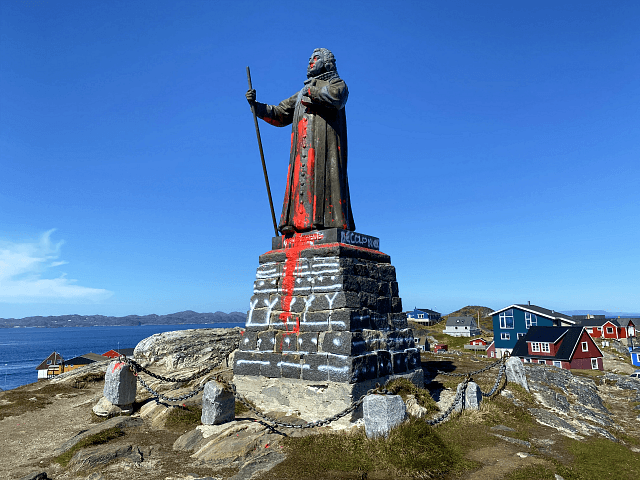People in Nuuk, Greenland, have voted overwhelmingly against removing a statue vandalised by activists.
In June, the clifftop statue of Norwegian missionary Hans Egede, who founded Nuuk — then known as Godthåb — and became Bishop of Greenland in the 1700s, was smeared with red paint and the slogan “DECOLONIZE”, prompting the authorities to organise a referendum on the monument’s fate.
But, despite the fact that Greenland, a territory of Denmark with a large degree of self-government — for example, it voted to leave the European Economic Community, as the European Union then was, in the 1980s, in large part to stop the bloc from controlling its territorial fisheries — is populated mainly by Greenlandic Inuits, with Danes and other Scandinavians accounting for less than 10 per cent of the population, the public voted overwhelmingly to keep the statue.
Voters who wished to maintain Egede’s monument as an important part of Greenland’s built heritage took over 60 per cent of the votes cast.
The poll marks one of the only times, if not the only time, the public have been given a direct say over historic monuments deemed “problematic” by left-liberal activists in the wake of George Floyd’s death in the United States, which has spawned a movement which has progressed rapidly from protesting police brutality to demanding the political and sometimes physical dismantling of Western institutions and symbols.
Local governments in countries such as Britain have set up dozens of audits and reviews of statues to decide whether they should be removed, replaced, or “put in context” through additional information boards and so on describing their subjects’ supposed crimes — but none appear to have offered the public a chance to decide at the ballot box.
Whether or not Nuuk’s authorities will respect the outcome of the vote in Greenland does remain to be seen, however, with the administration set to issue its final ruling on Egede’s statue in September.
It should be noted that the vast majority of those eligible to vote on the statue in Sermersooq municipality simply did not cast a ballot at all, however, perhaps suggesting that normal people are not half so exercised about the supposedly hot button issue of public monuments as BLM, left-wing activists, and the mainstream media have suggested.
Interestingly, Greenland was originally settled by the Norse hundreds of years before the ancestors of the Greenlandic Inuits, known as the Thule people, began arriving in the island’s north.
The first Norse settlers are believed to have arrived in Greenland with the Iclenadic exile Erik the Red in the 900s, and maintained their presence there until the 1400s.
The cause of the Norse settlements’ downfall remains contested, with academics suggesting a range of theories including an extended period of intensified cold and vital trade links with Europe collapsing following the Black Death as explanations for their demise.
Historic chronicles, however, suggest that the Western Settlement, at least, was overrun by the Inuit, with the cleric Ivar Bardarson reporting that a relief force from the Eastern Settlement “found no man, neither Christian nor heathen” there when they marched to its aid.

COMMENTS
Please let us know if you're having issues with commenting.